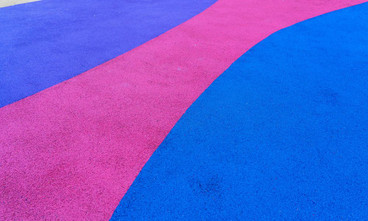Pour-in-place rubber is an innovative and versatile material for walkways, playgrounds, athletic fields, and more. Its base consists of 100 percent recycled rubber and a top layer of ethylene propylene diene monomer (EPDM). Nevertheless, it can wear down over the years. Troubleshoot the most common pour-in-place rubber surfacing issues with the information below.
Cracking and Tearing
Rubber surfacing in high-traffic areas sustains heavy use and constant exposure to environmental conditions, causing the rubber to lose its strength. When slight damage like cracks and tears arise, you have a few solutions to choose from.
Sealant Application
Use an elastic sealant that complements the existing surface in both color and texture for minor cracks. This sealant fills the cracks, blocks water infiltration, and prevents further damage. The surface should be dry and clean prior to application for optimal adhesion.
Patch Repairs
Small, localized imperfections are easy to fix with the patch repair method. Identify the damaged area, and clean it thoroughly. Cut a piece of matching rubber material to cover the crack or tear, and apply a specialized adhesive to the patch and the surface. Finally, press the patch firmly in place so it bonds well with the existing surface.
Overlay Resurfacing
When dealing with widespread yet shallow damage, try overlaying the entire area with a fresh layer of rubber granules combined with a binding agent. This repair technique will rejuvenate the look and functionality of the surface without a full replacement.
Discoloration
Discoloration in pour-in-place rubber surfacing is a cosmetic issue that can indicate underlying problems. It often results from UV exposure or the presence of harsh chemicals. Timely fixes will uphold the material’s original color and appearance.
Overcoating
Overcoating the entire surface with a layer of colored EPDM rubber granules mixed with a binder can revitalize the appearance of the playground or area. This not only addresses discoloration but also adds a layer of protection.
Complete Resurfacing
Complete resurfacing is the best long-term solution for extensive discoloration that affects most of the surface. While expensive, it will fix any other underlying issues.
Uneven Surfaces
Uneven surfaces impair the safety of pedestrians using rubber surface paths. The pour-in-place rubber may shrink and expand, or settle and erode for a patchy, unbalanced foundation. No matter the root of the problem, make sure the surface is level to eliminate tripping hazards.
Leveling and Compaction
To fix existing uneven surfaces in pour-in-place rubber flooring, re-level and compact the base layer of crushed stone or gravel. This creates a solid and stable foundation. Then, use mechanical equipment to press the particles together, strengthen density, and avoid future sinking or erosion beneath the pour-in-place rubber surfacing.
After preparing the base, consider adding new rubber on top. It’s the best way to improve the safety and functionality of the surface.
Patch Repairs
As with cracking and tearing, patch repairs are reliable for troubleshooting uneven surface issues with pour-in-place rubber. Target specific areas that present signs of raised or depressed materials. Removing the affected area and filling the section with new pour-in-place rubber will prolong the lifespan of the base.

